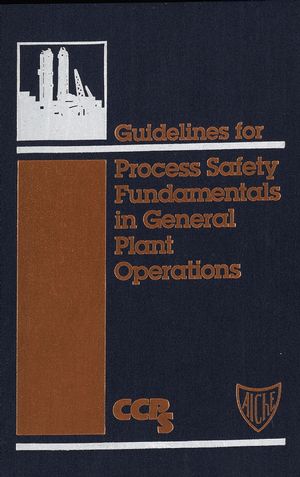Guidelines for Process Safety Fundamentals in General Plant OperationsISBN: 978-0-8169-0564-5
Hardcover
385 pages
April 1995
 This is a Print-on-Demand title. It will be printed specifically to fill your order. Please allow an additional 10-15 days delivery time. The book is not returnable.
|
||||||
Acknowledgments.
Acronyms and Abbreviations.
Glossary.
1. Introduction.
1.1 Objective.
1.2 Scope.
1.3 Organization.
References.
2. Materials/Chemical Handling.
2.1 Hazardous Property Identification.
2.2 Material handling Hazards.
2.2.1 Fire and Explosive Properties.
2.2.2 Chemical Toxicity.
2.2.3 Biological Hazards.
2.2.4 Radiation Hazards.
2.2.5 Electrical Hazards.
2.2.6 Thermal Hazards.
2.2.7 Physical Plant Hazards.
2.3 Material Transport.
2.4 Liquid Handling.
2.4.1 Liquid Transport.
2.4.2 Liquid Storage.
2.4.3 Spill Control and Cleanup.
2.5 Solids Handling.
2.5.1 Storage Procedures.
2.5.2 Transfer Procedures.
2.5.3 Bulk Conveying.
2.5.4 Solids Packaging.
2.6 Gas Handling.
2.6.1 Classification of Gases.
2.6.2 Regulations and Standards.
2.6.3 Gas Containers.
2.6.4 Cylinder Auxiliaries.
2.6.5 Cylinder Handling Procedures.
2.6.6 Handling Hazardous Gases.
2.6.7 Cryogenic Liquids.
2.7 Waste Handling.
2.7.1 Waste Disposal Plan.
2.7.2 Release Reporting.
2.7.3 Scrap and Salvage.
2.7.4 Vessel Decommissioning.
2.7.5 Waste Containers.
References.
3. Process Equipment and Procedures.
3.1 Materials of Construction.
3.1.1 Material Selection.
3.1.2 Material Application.
3.2 Corrosion.
3.2.1 Types of Corrosion.
3.2.2 Sources of Corrosion Information.
3.3 Small Containers.
3.3.1 Container Specification.
3.3.2 Manufacturer’s Quality Control.
3.3.3 Receiving.
3.3.4 Emptying of Containers.
3.3.5 Warehousing.
3.3.6 Loading and Shipping.
3.3.7 Disposal of Containers.
3.4 Piping.
3.4.1 Piping Codes and Specifications.
3.4.2 Piping Design Safety.
3.4.3 Piping Installation Safety.
3.4.4 Piping Operation Safety.
3.4.5 Piping Maintenance Safety.
3.5 Transfer Hoses.
3.5.1 Materials of Construction.
3.5.2 Safety in Design and Installation.
3.5.3 Safety in Operation.
3.5.4 Inspection and Maintenance.
3.6 Pumps.
3.6.1 Pump Types.
3.6.2 Pump Design Safety.
3.6.3 Pump Installation Safety.
3.6.4 Pump Operation Safety.
3.6.5 Pump Maintenance Safety.
3.7 Fans and Compressors.
3.7.1 Classification of Gas Movers.
3.7.2 Gas Mover Operating Parameters.
3.7.3 Gas Mover Safety Precautions.
3.8 Drivers.
3.8.1 Motors.
3.8.2 Steam Turbines.
3.8.3 Transmission.
3.9 Filters.
3.9.1 Safety Considerations.
3.9.2 Waste Minimization and Disposal.
3.10 Centrifuges.
3.10.1 Types of Centrifuges.
3.10.2 Design Considerations.
3.10.3 Operation.
3.10.4 Waste Minimization and Disposal.
3.11 Drying and Particle Size Reduction.
3.11.1 Dryers.
3.11.2 Size Reduction Equipment.
3.11.3 Screening Equipment.
3.11.4 Packaging of Hot Materials.
3.11.5 Deflagration Hazards.
3.11.6 Environmental Concerns and Hygiene.
3.12 Instrument and Controls.
3.12.1 I & C Design Safety.
3.12.2 I & C Installation Safety.
3.12.3 I & C Operation Safety.
3.12.4 I & C Maintenance Safety.
References.
4. General Topics.
4.1 Inspection, Maintenance, and Calibration.
4.1.1 Inspection Techniques.
4.1.2 Maintenance Manuals.
4.1.3 Preventive Maintenance.
4.1.4 Equipment Calibration.
4.2 Spare Parts and Equipment.
4.2.1 Receiving.
4.2.2 Storage.
4.2.3 Disbursement.
4.3 Storage and Warehousing.
4.3.1 General Storage Techniques.
4.3.2 Stored Materials and Containers.
4.3.3 Material Movement.
4.3.4 Shipping Vehicles.
4.4 Plant Modification.
4.4.1 Change Control Program.
4.4.2 Change/Work Authorization.
4.4.3 Training.
4.5 Hazardous Work.
4.5.1 Confined Space Entry.
4.5.2 Equipment Lockout.
4.5.3 Line Breaking and System Opening.
4.5.4 Hazardous materials.
4.5.5 Welding.
4.6 Outside Contractors.
4.6.1 Contract Language.
4.6.2 Pre- and Postcontract Meetings.
4.6.3 Contractor Safety Programs.
4.6.4 Monitoring.
4.6.5 Training.
4.6.6 HAZCOM and Hazard Analysis.
4.6.7 Enforcement.
4.7 Worker Protection.
4.7.1 Personal Protective Equipment.
4.7.2 Safety Showers and Eyewash Stations.
4.8 Control of Working Environment.
4.8.1 Temperature Extremes.
4.8.2 Oxygen Requirements.
4.8.3 Noise.
References.
5. Cleanup and Process Changeover.
5.1 Process Planning.
5.1.1 Process Development.
5.1.2 System Design.
5.1.3 Production Scheduling.
5.2 Cleanup Methods.
5.2.1 Chemical Cleaning.
5.2.2 Mechanical Cleaning.
5.2.3 Direct Entry.
5.3 Process Changeover.
5.3.1 Process Equipment Compatibility.
5.3.2 Equipment Preparation.
References.
6. Training.
6.1 Reasons for Training.
6.2 Personnel Requiring Training.
6.3 Training Methods.
6.3.1 On-the-job Training.
6.3.2 Group Training Techniques.
6.3.3 Individual Techniques.
6.3.4 School Courses.
6.4 Extent of Training.
6.4.1 Lesson Plans.
6.4.2 Course Outlines.
6.5 Frequency of Training.
6.6 Record Keeping.
6.7 Sources of Training Information.
6.7.1 Seminars.
6.7.2 Printed material.
6.7.3 Audio-Visual Material.
6.7.4 Training Kits.
6.7.5 Computer Software.
References.
7. Special Procedures and Programs.
7.1 Plant Safety Programs and Auxiliary Topics.
7.1.1 Process Hazard Reviews.
7.1.2 Facility and Operational Changes.
7.1.3 Emergency Response.
7.1.4 Permits.
7.1.5 Incident Investigating and Reporting.
7.1.6 Safety Manuals.
7.1.7 Safety Incentives.
7.1.8 Inspections and Reporting of Unsafe Conditions.
7.2 Industrial Programs.
7.3 Voluntary Programs.
7.3.1 Responsible Care®.
7.3.2 Service and Trade Associations.
7.3.3 Technical Societies.
7.4 Regulatory Programs.
7.4.1 Introduction.
7.4.2 Overview.
7.4.3 Examples.
References.
Index.



